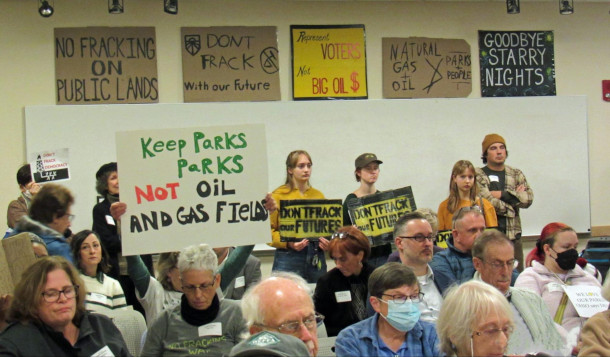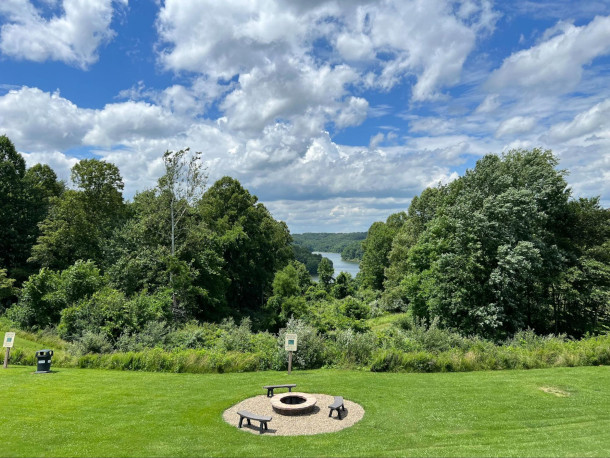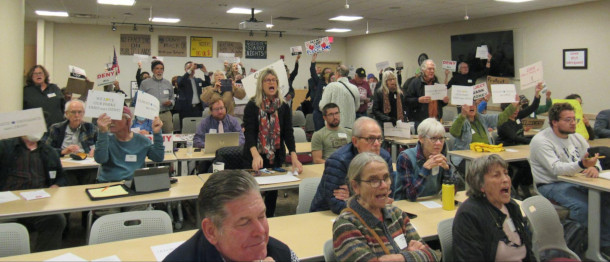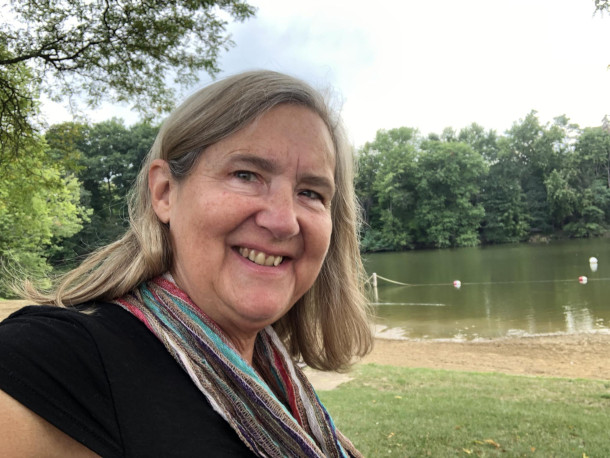Fracking Under Ohio State Parks
Air Date: Week of March 8, 2024

Protesters attended a meeting in November, when the Oil and Gas Land Management Commission voted to allow drilling and fracking under Salt Fork State Park, Valley Run Wildlife Area, and Zepernick Wildlife Area. (Photo: Cathy Cowan Becker/ Save Ohio Parks)
In Ohio, drilling and fracking may soon begin underneath Salt Fork State Park, Ohio’s largest, as well as the Valley Run and Zepernick State Wildlife Areas, despite legal attempts to halt the extraction. Energy News Network reporter Kathiann Kowalski joins Host Steve Curwood to describe concerns about the potential risks of drilling under these lands.
Transcript
CURWOOD: State parks and wildlife areas are spaces for nature that we humans can enjoy as well. But in Ohio, drilling and fracking may soon begin underneath some treasured places. The Ohio Oil and Gas [Land] Management Commission recently selected two companies to drill under Salt Fork State Park, Ohio’s largest, as well as the Valley Run and Zepernick State Wildlife Areas. Citizens groups have filed legal actions to block the extraction, but one has already been dismissed while another is still pending. The Ohio Department of Natural Resources could allow drilling and fracking under these parks to begin as early as this spring. Kathiann Kowalski covers the state of Ohio for Energy News Network. Welcome to Living on Earth, Kathi!
KOWALSKI: Glad to be here. Thank you.
CURWOOD: Kathi, talk to me about these areas in Ohio under which drilling and fracking might soon start. What are these places like?
KOWALSKI: They're lovely. Salt Fork Park is the largest state park in Ohio. It's more than 17,000 acres, mostly wooded. It's in Guernsey County, which is kind of the foothills of Appalachia. There's a large lake there, hiking trails, a lodge, there's cabins. It's just a great place for people in the area to go and experience nature. It's also a place that draws visitors from across the whole state. I'm actually planning to go there for an overnight stay after Easter.

Salt Fork State Park is the largest state park in Ohio with around 22,000 acres of land. (Photo: Ohio Environmental Council)
CURWOOD: And I guess there's some wildlife areas also in this part of Appalachia that fracking might start?
KOWALSKI: Yeah, there's the Valley Run Wildlife Area in Carroll County. That's 304 acres. It's mostly wooded with a small stream. There's the Zepernick Wildlife Area, up in Columbiana County, and that's 521 acres. And that's also got a lake and a lot of woods, and people do hunting and fishing and birding. Guernsey County, where Salt Fork Park is, and Carroll County where Valley Run is, are two of the top seven oil and gas producing counties in the state of Ohio. So that explains why the industry has an interest in drilling for part of the land there where it hasn't previously been drilling.
CURWOOD: So talk to me about the potential consequences of drilling and fracking in these areas. What are the opponents to this worried about here?

Valley Run Wildlife Area. (Photo: Courtesy of Melinda Zemper/Save Ohio Parks)
KOWALSKI: Well, the opponents are worried about air emissions in the area, they're worried about noise and light and extra traffic and additional industrial development while the drilling is going on. For example, you will have water being brought in to be mixed with chemicals for purposes of fracking. And that requires millions of gallons of fluids. And they're also just worried about possible accidents, possible spills of liquids. The actual drilling will take place outside the park in these instances. So it will be what they call laterals, horizontal piping coming in underneath the ground, a couple of thousand feet down. But anything that goes on on the surface, even if it's just outside the boundaries of the park, has the potential to affect the air, the groundwater, and the surface water there.
CURWOOD: What about concerns that there may need to be emergency evacuations? How often do those happen in conjunction with fracking?
KOWALSKI: There have been a handful of emergency evacuations over the last five years. But they do happen. They're rare. But when they have happened, usually you'll have people within half a mile or a mile having to get out of the way. And when we looked at accident data last year, the industry's position was well, gee, there were only a few instances that rose to the category of being major incidents. That means we're doing a good job. But the citizens groups were saying, wait a minute, even a handful of major incidents is too much when you're talking about something in or near a state park or wildlife area.

Zepernick Wildlife Area. (Photo: Courtesy of Melinda Zemper/Save Ohio Parks)
CURWOOD: Now, as I understand it, some of the opponents are opposing this on the grounds of hey, how smart is this in the context of climate change? What are they telling you?
KOWALSKI: They're saying it's not smart at all in the context of climate change. This is withdrawing more fossil fuels from the ground. Burning those fossil fuels emits greenhouse gases. Also there tend to be fugitive methane emissions from fracking pads and as natural gas is processed. So there's a real concern about adding to the carbon dioxide and methane that's already in the air, and methane has been identified as a more potent greenhouse gas than carbon dioxide.
CURWOOD: Yeah, much more potent, about 80 times more potent when it first is released. Hang on here, I mean, aren't state parks and wildlife areas supposed to be protected by definition, when they're established? I mean, how does the Ohio Department of Natural Resources justify their actions here?

Groups that oppose the projects include Save Ohio Parks, Ohio Environmental Council, Backcountry Hunters and Anglers, and Buckeye Environmental Network. (Photo: Cathy Cowan Becker/ Save Ohio Parks)
KOWALSKI: Their position is that because the drilling is under the surface, they believe that they are still preserving the uses of the properties on the surface. And they believe that extra terms they included will protect the rights of visitors to the parks. The citizens groups say those provisions are inadequate. And they also say, regardless of what the Ohio Department of Natural Resources says, they believe, yes, their enjoyment of the parks will be interfered with. And these are supposed to be lands set aside for everybody's enjoyment.

Opponents argue that fracking threatens water and air quality in the area. They are also concerned about increased greenhouse gas emissions, increased industrial activity, and possible evacuations. (Photo: Paul Becker/Becker1999, Flickr, CC BY 2.0)
CURWOOD: So talk to me about the supporters of these projects, the oil and gas industry. I mean, what do they say are the benefits to the public that come from drilling and fracking under state parks and wildlife areas?
KOWALSKI: Their position is that they are getting energy resources that people need and use. And their position is also that this is going to produce revenue for the state of Ohio. The state will get $58.4 million from Infinity Natural Resources based in West Virginia for the parcels at Salt Fork State Park. Encino Energy will pay a little more than a million dollars for parcels at Valley Run Wildlife Area. And then it will pay about $230,000 for the parcel at Zepernick Wildlife Area. Those amounts are in addition to the royalty amounts of 12 and a half percent. And that's less than the current market value of about 25%.
CURWOOD: What do you see as the long-term potential consequences of allowing these projects to go forward?
KOWALSKI: Well, first, you would have the risk of lasting environmental harm if something goes wrong. And that is a serious concern when there's a relatively small percentage of land in Ohio set aside for public parks and wildlife areas at the state level. And then for Ohio and beyond, the whole situation calls into question the nature of state parks and wildlife areas as being for everyone rather than for the profit interests of a few companies.

Kathiann Kowalski is a Cleveland-based reporter who covers the state of Ohio for Energy News Network. In addition to her journalism career, Kathi is an alumna of Harvard Law School and has spent 15 years practicing law. (Photo: Kathiann Kowalski)
CURWOOD: Kathiann Kowalski is a reporter based in the Cleveland area, who covers the state of Ohio for Energy News Network. Thank you so much.
KOWALSKI: Thank you, glad to be here.
Links
Franklin County Judge Jaiza Page’s February 23 decision to dismiss environmental groups’ appeal
Opponents’ November 30 appeal to decision to allow drilling under Ohio state park and wildlife areas
Oil and Gas Commission November 15 Meeting Highlight Reel Video (Save Ohio Parks)
Initial 2011 law that allows oil and gas drilling in state-owned lands in Ohio
Living on Earth wants to hear from you!
Living on Earth
62 Calef Highway, Suite 212
Lee, NH 03861
Telephone: 617-287-4121
E-mail: comments@loe.org
Newsletter [Click here]
Donate to Living on Earth!
Living on Earth is an independent media program and relies entirely on contributions from listeners and institutions supporting public service. Please donate now to preserve an independent environmental voice.
NewsletterLiving on Earth offers a weekly delivery of the show's rundown to your mailbox. Sign up for our newsletter today!
 Sailors For The Sea: Be the change you want to sea.
Sailors For The Sea: Be the change you want to sea.
 The Grantham Foundation for the Protection of the Environment: Committed to protecting and improving the health of the global environment.
The Grantham Foundation for the Protection of the Environment: Committed to protecting and improving the health of the global environment.
 Contribute to Living on Earth and receive, as our gift to you, an archival print of one of Mark Seth Lender's extraordinary wildlife photographs. Follow the link to see Mark's current collection of photographs.
Contribute to Living on Earth and receive, as our gift to you, an archival print of one of Mark Seth Lender's extraordinary wildlife photographs. Follow the link to see Mark's current collection of photographs.
 Buy a signed copy of Mark Seth Lender's book Smeagull the Seagull & support Living on Earth
Buy a signed copy of Mark Seth Lender's book Smeagull the Seagull & support Living on Earth

